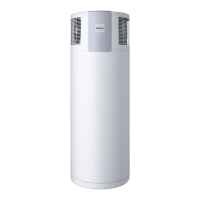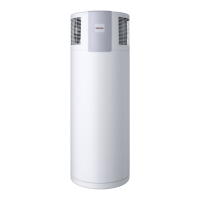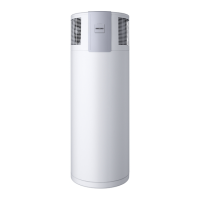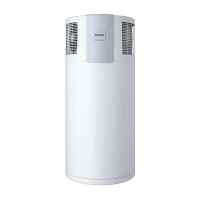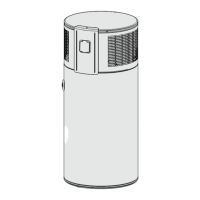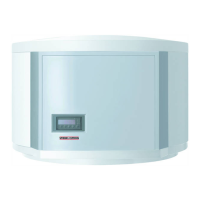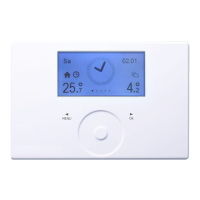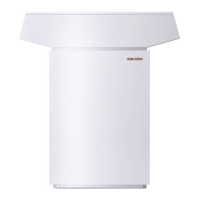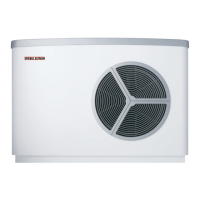OpEraTiON
Appliance description
www.stiebel-eltron.com WWK222-302 H | 7
For information on the heat-up time, see chapter "Specification".
The calculation of the available mixed water volume is based on
the average cylinder temperature. The mixed water volume is
only calculated if the water temperature in the upper section of
the cylinder is higher than 40°C.
DHW is normally heated by the heat pump of the appliance (see
chapter "Specification/ Data table").
Note
If the appliance has been isolated from the power supply
during operation, the compressor will only restart after
the pressure inside the refrigerant circuit has been equal-
ised. Pressure equalisation can take several minutes.
WWK 222 H | WWK 302 H : Electric emergency/booster heater
When the temperature in the upper section of the DHW cylinder
drops 12K below the selected set temperature, the appliance
automatically switches on the electric emergency/booster heater.
When the temperature in the upper section of the DHW cylinder
rises 2K above the selected set temperature, the appliance switch-
es off the electric emergency/booster heater.
In the event of an appliance fault, the electric emergency/booster
heater can be activated in emergency heating mode, provided
a flashing fault key is displayed. See chapter "Settings/ 'Rapid
heat-up' button/ Emergency heating mode".
In the event of a higher hot water demand on a single occasion,
use the "Rapid heat-up" button to activate the emergency/booster
heater manually for one-off heat-up in addition to the heat pump.
See chapter "Settings/ 'Rapid heat-up' button/ Rapid/comfort
heat-up".
3.3 Appliance operation outside the application
limits
To guarantee fault-free operation of the appliance, make sure
you operate the appliance within its application limits (see
chapter "Specification/ Data table").
3.3.1 Ambient temperatures below the application limit
Outside the application limits, the appliance blocks the compres-
sor from operating. This could lead to reduced DHW convenience.
If the appliance has an electric emergency/booster heater, the
appliance enables this when there is a demand for water heating
and the lower application limit has been undershot.
Low ambient temperatures may result in the formation of hoar
frost on the evaporator depending on the air humidity and water
temperature.
Active defrosting
The appliance is equipped with active hot gas defrosting, which
allows quick defrosting of the evaporator when needed. During
defrosting, the appliance fan is disabled. The compressor con-
tinues to run. A solenoid valve routes the hot gas directly to the
evaporator. While this is happening, refrigerant flow to the con-
denser is disabled by another solenoid valve.
In contrast to conventional defrosting methods, the appliance
guarantees that this defrosting takes place only when needed.
Note
Heat-up times are longer while the evaporator is defrost-
ing.
3.3.2 Ambient temperatures above the application limit
Outside the application limits, the appliance blocks the compres-
sor. This could lead to reduced DHW convenience. If the appliance
has an electric emergency/booster heater, the appliance enables
this when there is a demand for water heating and the upper
application limit has been exceeded.
3.4 Frost protection
The appliance activates the frost protection function if the integral
sensor in the DHW cylinder captures a temperature below 8°C.
The appliance then heats the water by means of the heat pump
and the electric emergency/booster heater. The heat pump and
electric emergency/booster heater switch off when the tempera-
ture captured by the integral sensor reaches 16°C.
3.5 Minimum runtime and minimum pause time
!
Material losses
When operating with external switching devices that
can interrupt the power supply to the appliance, such
as time switches, energy management systems or home
automation systems, the following conditions must be
adhered to:
- The minimum ON time is 60 minutes.
- The minimum pause time following a shutdown is
20 minutes.
- The appliance should not be switched on/off more
than 10 times per day.
- The breaking capacity of the switching actuator must
meet the fuse protection requirements (see chapter
"Specification/ Data table").
!
Material losses
If you disconnect the appliance from the power supply, it
is no longer protected against frost.
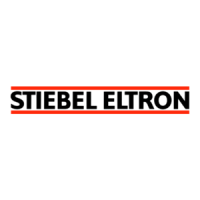
